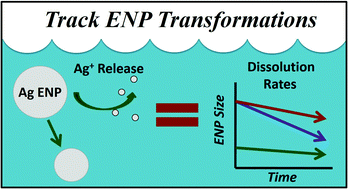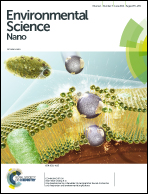Tracking dissolution of silver nanoparticles at environmentally relevant concentrations in laboratory, natural, and processed waters using single particle ICP-MS (spICP-MS)†
Abstract
The interplay between engineered nanoparticle (ENP) size, surface area, and dissolution rate is critical in predicting ENP environmental behavior. Single particle inductively coupled plasma mass spectrometry (spICP-MS) enables the study of ENPs at dilute (ng L−1) concentrations, facilitating the measurement of ENP behavior in natural systems. Here, the utility of using spICP-MS to quantitatively track the changes in particle diameter over time for 60 and 100 nm Ag ENPs (citrate, tannic acid, and polyvinylpyrrolidone coated) was demonstrated. Short term (<24 h) and intermediate term (1 week) dissolution was examined, with rates for all particles slowing by over an order of magnitude after approximately 24 h. Dissolution was measured primarily as a decrease in particle diameter over time but direct measurement of Ag+(aq) was also completed for the experiments. The importance of water chemistry including chloride, sulfide, and dissolved organic carbon (DOC) was demonstrated, with higher concentrations (1 mg L−1 Cl−, S2− and 20 mg L−1 DOC) resulting in negligible Ag ENP dissolution over 24 h. Slight decreases in particle diameter (<10%) were observed with lower concentrations of these parameters (stoichiometric Cl−, S2− and 2 mg L−1 DOC). Capping agents showed variable effects on dissolution. ENP behavior was also investigated in natural (moderately hard water, creek water) and tap water. Water chemistry was the most significant factor affecting dissolution. Near complete dissolution was observed in chlorinated tap water within several hours. Though modeled as first-order kinetic transformations, the dissolution rates observed suggested the dissolution kinetics might be significantly more complex. Two specific highlights of the benefits of using the spICP-MS technique to measure dissolution in complex samples include 1) the measurement of primary particle size as the metric of dissolution is more direct than attempting to measure the increase of Ag+ in solution and 2) that this is possible even when known sinks for Ag+ exist in the system (e.g. DOC, sediments, biota, sampling container).


 Please wait while we load your content...
Please wait while we load your content...